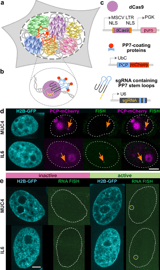NYU Researchers Unveil Gene Motion Insights: Key to Understanding Cancer and Cardiovascular Disorders
October 23, 2024
A team of researchers from New York University, led by professor Alexandra Zidovska, has made significant discoveries regarding the connections between gene activity, genome packing, and genome-wide motions that affect gene regulation and expression.
Their findings, published in the journal Nature Communications, emphasize the importance of transcription-driven motions of genes in understanding human health and diseases such as cancer and cardiovascular disorders.
Using advanced techniques like displacement correlation spectroscopy (DCS) and high-resolution live cell microscopy, the researchers tracked gene motion and chromatin dynamics in real-time.
They employed CRISPR technology to label single genes, allowing for the visualization of gene dynamics in live human cells.
The study specifically focused on the transcription of genes MUC4 and IL6, investigating how their activation contributes to large-scale chromatin dynamics.
Transcriptional activation of these genes was confirmed using inflammatory stimuli, with nascent RNA visualized to demonstrate active transcription.
The researchers theorized that molecular motors powered by ATP drive the movement of DNA within the cell nucleus, although further investigation is required to fully understand these mechanisms.
Zidovska highlighted that understanding these transcription-driven motions is crucial for comprehending the organization of the human genome, which contains two meters of DNA compacted within a nucleus just 10 micrometers in diameter.
The organization of the genome in space and time is vital for cellular processes and significantly impacts the central dogma of biology.
This research contributes to the understanding of the physics of active living systems, shedding light on the behavior of the human genome.
The study revealed that in low-compaction regions, active genes drive genome motion, while in high-compaction areas, the compactness of the genome influences gene motion.
Analysis showed that both MUC4 and IL6 exhibit subdiffusive motion patterns, with their dynamics changing upon activation.
Summary based on 4 sources
Get a daily email with more Science stories
Sources

Phys.org • Oct 22, 2024
Scientists uncover how transcription drives motion within the genome
ScienceDaily • Oct 22, 2024
Stirred, not shaken: Scientists uncover how transcription drives motion within the genome
News-Medical • Oct 22, 2024
New insights into how gene transcription influences genome motion